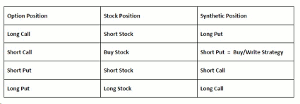Understanding synthetic positions can be very useful, particularly when liquidating a position, so Fred Oltarsh, at Options Strategy Network, shares a table which shows how the combination of an options position and a stock position creates a synthetic position and how this alternative strategy can go a long way to saving a trader money.
A previous article about covered calls touched on the idea that using a covered call is the same as selling puts. While it can be difficult to quickly translate into a synthetic position—which a covered call is—understanding synthetic positions can be very useful, particularly when liquidating a position. The chart below lists various synthetic positions. Sometime an alternative strategy with the same result—like a synthetic transaction—can go a long way to saving a trader money. Synthetic positions are one of the methods for initiating or liquidating a position, which may be useful.
When one has a deep in-the-money option, it is almost always easiest and least expensive to liquidate the option by trading the stock alone. While this may be capital intensive at times, it will increase one’s bottom line in the long run. For example, if one is long a put and it is getting deeper and deeper in-the-money, rather than selling the put in a relatively illiquid market, one can buy the stock to lock in the profit. If the calls are still bid, they can be sold as well to lock in a conversion. There are multiple ways to use synthetics to minimize the costs of trading somewhat illiquid markets.
Synthetic Positions
- The combination of options and shares of stock provides for synthetic options positions as displayed in the following table
- These interchangeable/arbitragable positions enable market-makers to establish risk free positions and provide liquidity
- It shows how the combination of an options position and a stock position creates a synthetic position: Options Position+Stock Position=Synthetic
Note That Synthetic Short Put Equals Popular Buy/Write Strategy
Options trading involves significant risk and is not suitable for every investor. The information is obtained from sources believed to be reliable, but is no way guaranteed. Past results are not indicative of future results.
By Fred Oltarsh, Proprietary Trader and Editor, Options Strategy Network



















